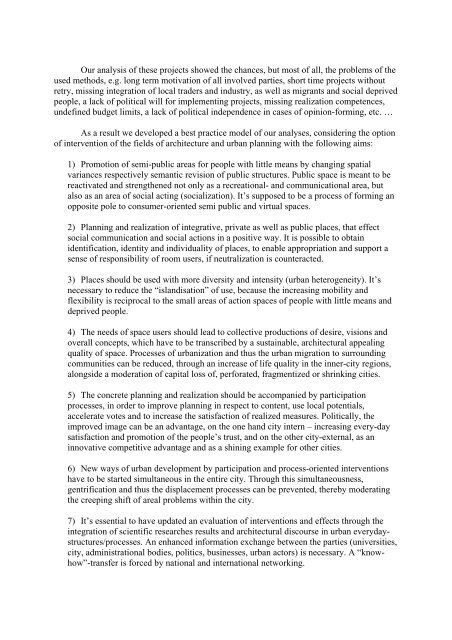HOW CAN PARTICIPATORY PRACTICES HAVE AN INPACT ON ...
HOW CAN PARTICIPATORY PRACTICES HAVE AN INPACT ON ...
HOW CAN PARTICIPATORY PRACTICES HAVE AN INPACT ON ...
Create successful ePaper yourself
Turn your PDF publications into a flip-book with our unique Google optimized e-Paper software.
Our analysis of these projects showed the chances, but most of all, the problems of the<br />
used methods, e.g. long term motivation of all involved parties, short time projects without<br />
retry, missing integration of local traders and industry, as well as migrants and social deprived<br />
people, a lack of political will for implementing projects, missing realization competences,<br />
undefined budget limits, a lack of political independence in cases of opinion-forming, etc. …<br />
As a result we developed a best practice model of our analyses, considering the option<br />
of intervention of the fields of architecture and urban planning with the following aims:<br />
1) Promotion of semi-public areas for people with little means by changing spatial<br />
variances respectively semantic revision of public structures. Public space is meant to be<br />
reactivated and strengthened not only as a recreational- and communicational area, but<br />
also as an area of social acting (socialization). It’s supposed to be a process of forming an<br />
opposite pole to consumer-oriented semi public and virtual spaces.<br />
2) Planning and realization of integrative, private as well as public places, that effect<br />
social communication and social actions in a positive way. It is possible to obtain<br />
identification, identity and individuality of places, to enable appropriation and support a<br />
sense of responsibility of room users, if neutralization is counteracted.<br />
3) Places should be used with more diversity and intensity (urban heterogeneity). It’s<br />
necessary to reduce the “islandisation” of use, because the increasing mobility and<br />
flexibility is reciprocal to the small areas of action spaces of people with little means and<br />
deprived people.<br />
4) The needs of space users should lead to collective productions of desire, visions and<br />
overall concepts, which have to be transcribed by a sustainable, architectural appealing<br />
quality of space. Processes of urbanization and thus the urban migration to surrounding<br />
communities can be reduced, through an increase of life quality in the inner-city regions,<br />
alongside a moderation of capital loss of, perforated, fragmentized or shrinking cities.<br />
5) The concrete planning and realization should be accompanied by participation<br />
processes, in order to improve planning in respect to content, use local potentials,<br />
accelerate votes and to increase the satisfaction of realized measures. Politically, the<br />
improved image can be an advantage, on the one hand city intern – increasing every-day<br />
satisfaction and promotion of the people’s trust, and on the other city-external, as an<br />
innovative competitive advantage and as a shining example for other cities.<br />
6) New ways of urban development by participation and process-oriented interventions<br />
have to be started simultaneous in the entire city. Through this simultaneousness,<br />
gentrification and thus the displacement processes can be prevented, thereby moderating<br />
the creeping shift of areal problems within the city.<br />
7) It’s essential to have updated an evaluation of interventions and effects through the<br />
integration of scientific researches results and architectural discourse in urban everydaystructures/processes.<br />
An enhanced information exchange between the parties (universities,<br />
city, administrational bodies, politics, businesses, urban actors) is necessary. A “knowhow”-transfer<br />
is forced by national and international networking.


